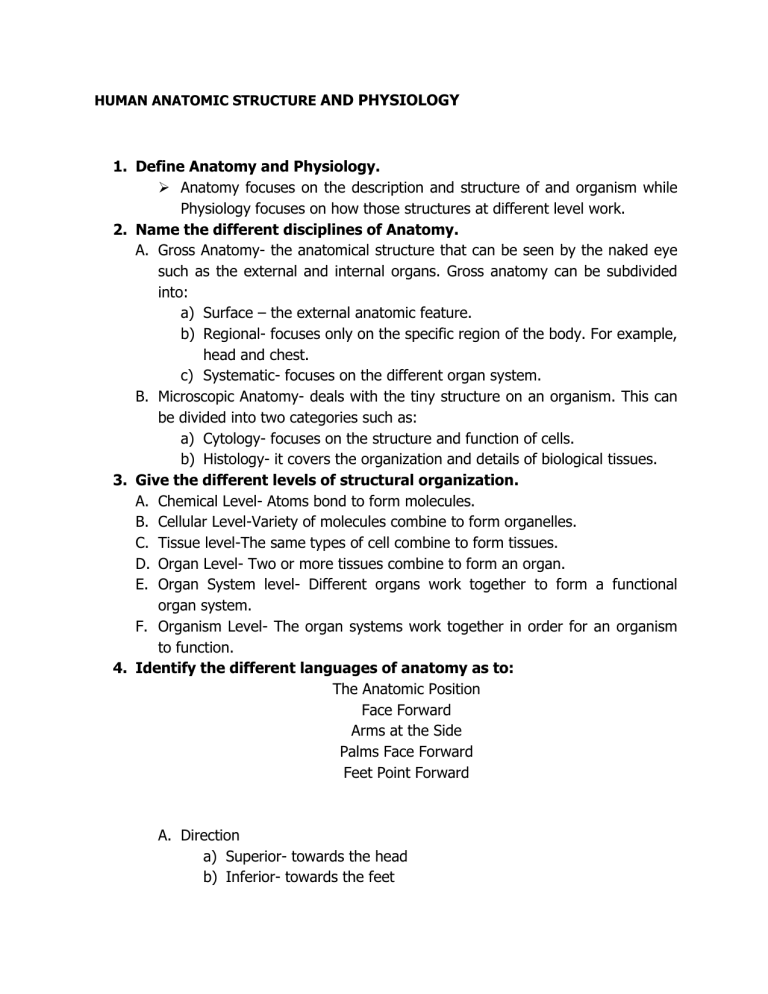Human Anatomy & Physiology: Definitions, Levels, Language
advertisement

HUMAN ANATOMIC STRUCTURE AND PHYSIOLOGY 1. Define Anatomy and Physiology. Anatomy focuses on the description and structure of and organism while Physiology focuses on how those structures at different level work. 2. Name the different disciplines of Anatomy. A. Gross Anatomy- the anatomical structure that can be seen by the naked eye such as the external and internal organs. Gross anatomy can be subdivided into: a) Surface – the external anatomic feature. b) Regional- focuses only on the specific region of the body. For example, head and chest. c) Systematic- focuses on the different organ system. B. Microscopic Anatomy- deals with the tiny structure on an organism. This can be divided into two categories such as: a) Cytology- focuses on the structure and function of cells. b) Histology- it covers the organization and details of biological tissues. 3. Give the different levels of structural organization. A. Chemical Level- Atoms bond to form molecules. B. Cellular Level-Variety of molecules combine to form organelles. C. Tissue level-The same types of cell combine to form tissues. D. Organ Level- Two or more tissues combine to form an organ. E. Organ System level- Different organs work together to form a functional organ system. F. Organism Level- The organ systems work together in order for an organism to function. 4. Identify the different languages of anatomy as to: The Anatomic Position Face Forward Arms at the Side Palms Face Forward Feet Point Forward A. Direction a) Superior- towards the head b) Inferior- towards the feet c) Anterior (Ventral)- front d) Posterior (Dorsal)- back e) Medial –towards the midline of the body f) Lateral- towards the side of the body g) Proximal – closer to the axial h) Distal- further to the axial i) Superficial- closer to the surface of the body j) Deep- further from the surface B. Planes and Section a) Sagittal- runs vertically from top to bottom. It divides the body into left and right hemisphere. b) Oblique- called as the “odd angles” since it runs from any angle other than horizontal and vertical. c) Transverse- divides the body into top and bottom. d) Frontal- divides the body into anterior and posterior sides. C. Body Cavities a) Ventral Cavity- largest cavity that contains the Thoracic cavity and Abdominal cavity, which contains the abdominal an pelvic cavities. b) Dorsal Cavity- the cavity at the back of the body. It can be divided into two parts such as: cranial cavity, which houses the brain and vertebral, which houses the spinal chord. c) Minor Cavities: oral, orbital, nasal, middle ear, synovial D. Quadrants- made by intersecting median plane and transverse plane. a) Right Upper Quadrant Liver Stomach Gallbladder Duodenum Right Kidney Pancreas Transverse colon Right Adrenal Gland b) Left Upper Quadrant Liver Left Adrenal Gland Stomach Left Kidney Pancreas Spleen Transverse colon Small intestine c) Right Lower Quadrant Large intestine Appendix Right Ureter d) Left Lower Quadrant Small and large intestine Left ureter E. Regions a) Right and Left Hypochondriac- below cartilage b) Left and Right Lumbar- nearest to the side c) Left and Right Iliac- closest to hipbone d) Epigastric- above stomach e) Umbilical- central region f) Hypogastric- below stomach








